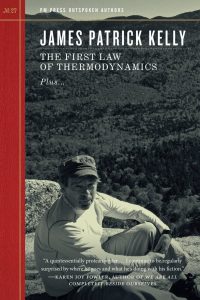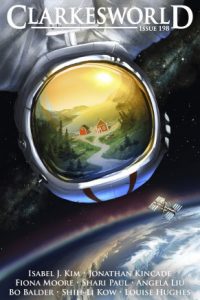Gary K. Wolfe reviews China Miéville
Three Moments of an Explosion, China Miéville (Tor UK 978-0230770171, £18.99, 400pp, hc) July 2015. (Del Rey 978-1-101-88472-0, $27.00, 386pp, hc) August 2015.
 China Miéville’s devout following is all the more remarkable because he never does quite the same thing twice. Since he left Bas Lag more than a decade ago, his novels have ranged from horror to SF to detective stories to young adult fantasies, differing in tone as well as in genre and hardly offering the sense of comfortable return that readers come to expect from a favored author; this is probably one reason that virtually every new novel gets proclaimed on message boards as both his best and his worst. But while his novels have always been, well, novel, in their initial premises (an ocean of railways! two cities occupying the same space but invisible to each other!), they tend to play out more conventionally in terms of form. For that sort of experimentalism, we need to turn to his short fiction, such as the graphic story included in his first collection Looking for Jake and Other Stories. It’s been nearly ten years since that collection appeared, and while we saw a remarkable string of five novels during that period, the short fiction has been less visible, sometimes appearing in such hard-to-find venues as an art exhibit handout or a World Fantasy giveaway. Therefore it seems fair to say that most of the contents of Three Moments of An Explosion: Stories will be new to readers, apart from the fact that ten of the 28 stories appear for the first time in print – and some are likely to be puzzling as well.
China Miéville’s devout following is all the more remarkable because he never does quite the same thing twice. Since he left Bas Lag more than a decade ago, his novels have ranged from horror to SF to detective stories to young adult fantasies, differing in tone as well as in genre and hardly offering the sense of comfortable return that readers come to expect from a favored author; this is probably one reason that virtually every new novel gets proclaimed on message boards as both his best and his worst. But while his novels have always been, well, novel, in their initial premises (an ocean of railways! two cities occupying the same space but invisible to each other!), they tend to play out more conventionally in terms of form. For that sort of experimentalism, we need to turn to his short fiction, such as the graphic story included in his first collection Looking for Jake and Other Stories. It’s been nearly ten years since that collection appeared, and while we saw a remarkable string of five novels during that period, the short fiction has been less visible, sometimes appearing in such hard-to-find venues as an art exhibit handout or a World Fantasy giveaway. Therefore it seems fair to say that most of the contents of Three Moments of An Explosion: Stories will be new to readers, apart from the fact that ten of the 28 stories appear for the first time in print – and some are likely to be puzzling as well.
While Miéville hasn’t quite left behind his earlier fascination with the shapes of the shapeless – animate blobs, tangles, and bits of garbage – he has begun to experiment more with the possible forms of fiction, often inviting the reader to fill in the blanks in a story that may take the form of scripts for trailers of imaginary movies (‘‘The Crawl’’, ‘‘Escapee’’, ‘‘Listen the Birds’’), a manifesto for a neo-representationalist art movement (‘‘The Second Slice Manifesto’’), rules for a card game (‘‘Rules’’), or an academic course syllabus (‘‘Syllabus’’). He experiments with risky second-person narration, sometimes to the extent of turning a story into a dramatic monologue (as with ‘‘The Buzzard’s Egg,’’ in which a wartime captor speaks to an icon of the defeated city’s god). One story simply speculates on why Orpheus turns around during his journey from the underworld (the best is ‘‘to ask Eurydice what it was he was or wasn’t supposed to do’’).
These are mostly brief, witty pieces, but there is no shortage of more substantial fiction here as well. The most effective stories are ‘‘Polynia’’, which reads like a Magritte painting come to life in its description of enormous icebergs which appear floating above London; ‘‘The Dowager of Bees’’, which describes a worldwide secret society of card players who have encountered rare ‘‘hidden suits’’ of cards like the Eight of Chains or the Dowager of Bees; ‘‘Sacken’’, a more or less straight horror tale involving a bizarre ancient German form of execution, which includes moments of sheer weirdness that might have come from a Takashi Miike film; ‘‘After the Festival’’, a reality-TV parody involving slaughtering a pig whose carved-out head is then worn by a volunteer, with predictable EC-Comics results; and ‘‘The Design’’, perhaps the most elegantly written tale here. It’s narrated at a distance of some decades by a physician whose medical-school colleague once found elaborate and impossible scrimshaw-like etchings on the bones of a cadaver (there may be a very odd meme about literalized internalization emerging here, since Daryl Gregory wrote about a serial torturer who scrimshawed the bones of his victims and Helen Marshall a story about a woman who finds a lost Jane Austen novel on the inside of her skin).
Other stories may seem more conventional by comparison. ‘‘In the Slopes’’ has archeologists exploring the aftermath of an ancient volcano and discovering that aliens apparently co-existed with the other victims; it’s closer to normal SF than anything here except the less-developed ‘‘The Rope is the World’’, which deals with space elevators. ‘‘The Junket’’ is a bitter but incisive parody of Hollywood – and the best evidence of Miéville’s mordant humor – in its description of the controversy which rages over a film about Anne Frank that isn’t all that far removed from some recent actual literary travesties. ‘‘Dreaded Outcome’’ is the most conventional of these tales – it could easily have appeared in Ellery Queen’s – in describing a therapist with an unorthodox technique for alleviating patients’ anxieties. In a few cases, even a clearly written tale with credible characters can’t quite keep the initial premise from seeming a bit heavy-handed, as happens in ‘‘Keep’’, in which trenches spontaneously incise themselves around troubled people, or in ‘‘Covehithe’’, a well-written invasion tale that would be more convincing if it weren’t an invasion of oil rigs uprooting themselves and tromping ashore like Wells’s Martians. In general, though, Miéville is as brilliant as ever in finding the necessary balance between narrative mode and unfettered invention – it’s the almost flat, documentary style that sells us on those icebergs in ‘‘Polynia’’, for example – and there’s more than enough here to suggest that his fiction may actually turn out to be more adventurous in the future than it has been in the past.




